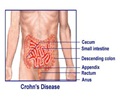Post operative complications of pancreatic surgery include bleeding,infections and anastomotic dehiscence.Obstruction of bowel can result from conditions like internal hernia and sometimes, even intussusception after the surgery.
Intussusception is often a pediatric condition. Adult cases have rarely been reported, and are usually caused by a lead point. The paper published by Dr. Luis Leon¡¯s group on the November 28 issue of World Journal of Gastroenterology describes a rare case of adult intussusception without lead points. Cases without lead points are most often seen after gastric bypasses for morbid obesity or after biliary reconstruction for choledochal cysts. Intussusception occurring after pancreatic duct reconstructions is rare. The report represents the second report in the literature of such an occurrence.This patient was quite a challenge for surgeons at the University of Arizona. She was a middle-aged female who presented with abdominal pain and vomiting of 24-hour duration. Her history was significant for pancreas divisum and chronic pancreatitis. Four years prior, she underwent a Whipple procedure as therapy for her pancreatic abnormalities. The indications to perform a Whipple procedure to correct pancreas divisum are questioned by the authors in their paper. She required revision one year later with a Puestow operation due to stricture of the pancreatico-intestinal anastomosis. Ever since, she had been experiencing intermittent abdominal pain for which she had been prescribed strong pain killers, with only partial relief. Upon arrival at the University of Arizona, severe tenderness to abdominal palpation was elicited. Emergent surgical intervention was deemed necessary. An intussusception just distal to the most distal Roux-en-Y connection was found, causing two loops of dilated small bowel up to 10-cm in maximal diameter, and also about 1 foot of non-perforated necrotic small bowel. The intussusception was antegrade, obstructing both Roux-en-Y reconstructions. No lead point lesions were seen. The intussuscepted intestine was reduced, the necrotic bowel resected, and a side-to-side anastomosis between the most distal aspect of the bowel and the Roux-en-Y reconstruction that was directed towards the Puestow procedure was performed. She was subsequently discharged without complications.
The chronic nature and severity of this patient's symptoms made her diagnosis very challenging. Previously performed CT scans showed findings that, in retrospect, suggest transient short bowel segment intussusceptions. The authors postulate that this complication may be a severe variant of Roux-en-Y stasis syndrome. The myoelectric activity of the Roux limb is often dysfunctional, split and retrograde and of high amplitude. It is possible that the intussusception seen in this patient was the result of severe disruption of the intestinal pacemaker activity, which is even more likely in the absence of lead points.
Antegrade intussusception after pancreatic surgery is extremely rare. This report by Dr. Leon's group is the second such occurrence. Their patient had previous episodes of abdominal pain and vomiting, which suggests that altered intestinal motility may have contributed to her presentation. Intussusception should always be considered in cases of bowel obstruction in adults after pancreatic reconstructions.
Source-Eurekalert
MED/P









